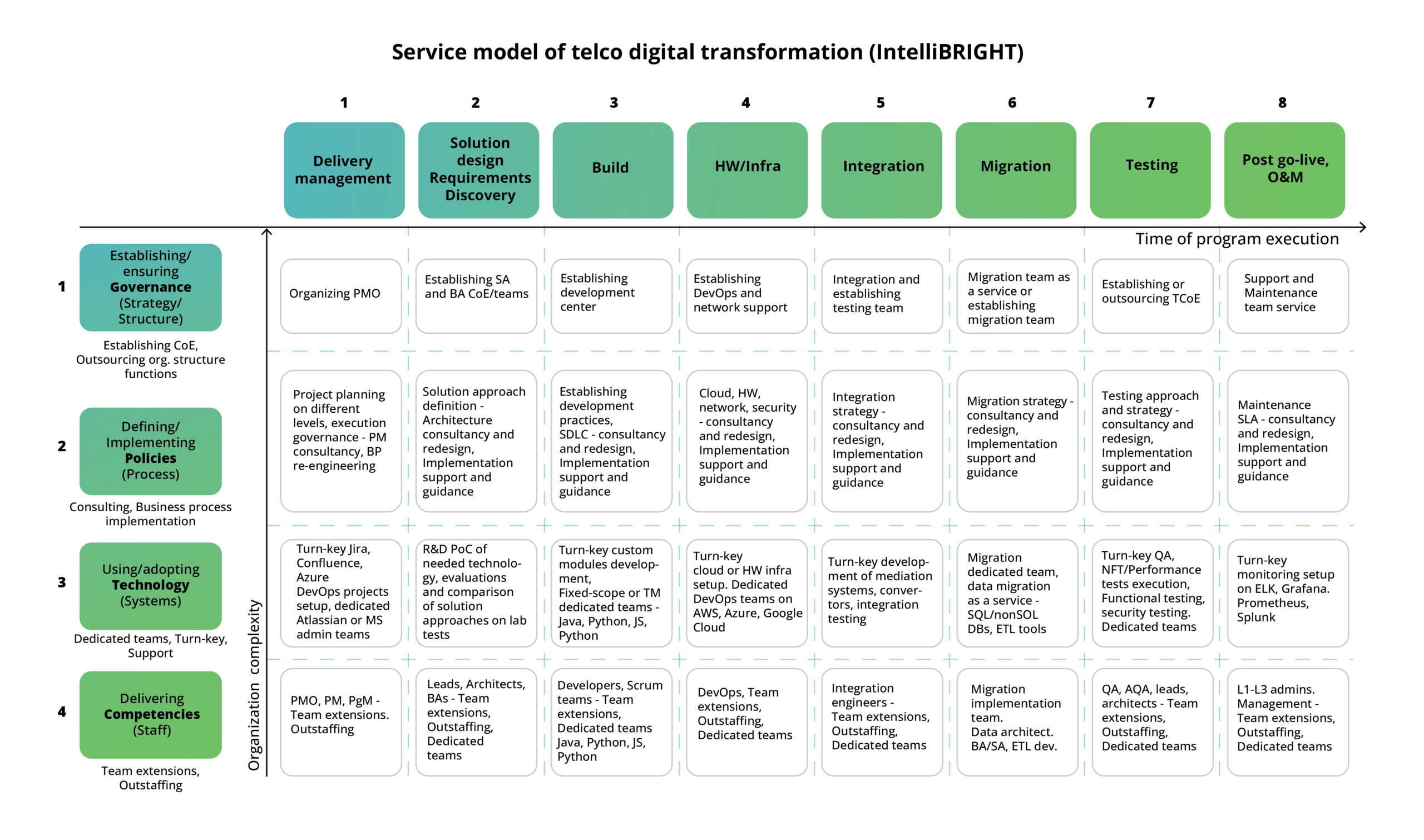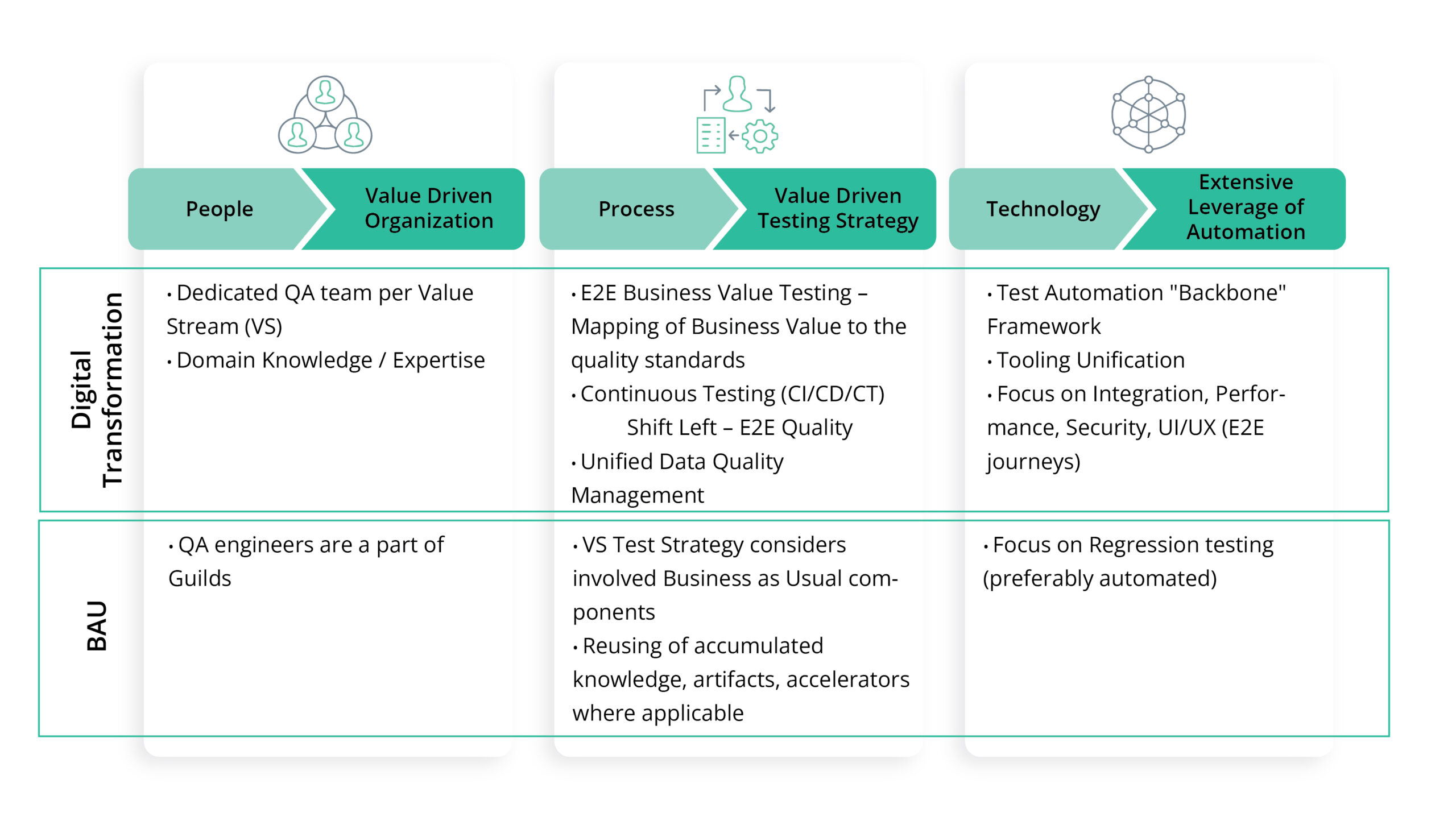Venturing into core system transformations is what happens to communication service providers (CSPs) that decide to replace their legacy business support systems (BSS) and operations support systems (OSS) with digital BSS transformation solutions. This shift is essential for staying competitive in today’s fast-paced digital landscape, but it isn’t a step to take lightly.
Business support systems manage vital processes such as product cataloging, ordering, billing, and customer care, influencing almost every activity a CSP undertakes. These systems also play a crucial role in leveraging big data insights for new services.
And when CSPs manage BSS transformation effectively, the rewards are substantial.
What exactly is digital BSS transformation?
A BSS transformation project is not only about upgrading the essential systems that telecom companies rely on for their operations, such as billing, customer service, and order management. It also involves creating new building blocks and capabilities, such as new digital channels, partner channels, and AI-driven business processes.
Legacy systems are outdated, inflexible, and expensive to maintain. They hinder the ability to launch new services, integrate with partners, and adapt to changing customer needs. Many CSPs struggle with multiple BSS/OSS applications that can’t be fully integrated or can’t share data effectively, leading to inefficiencies and errors. The problem gets even worse when the BSS landscape is formed through series of mergers and acquisitions (M&A) deals, resulting in a complex tapestry of non-integrable technologies and proprietary data formats.
Switching to a digital BSS/OSS solution can help CSPs manage costs, increase revenue, improve customer service, and support new offerings. This unified approach simplifies billing and customer service processes, enabling CSPs to manage their product portfolios more effectively.
There are two main goals for a BSS/OSS transformation:
- Revamp and transform business processes: Enable new capabilities and create more agile and responsive business models.
- Modernize IT applications and technologies: Cloudify and standardize systems to improve IT operations, speed up the time to market, and support high levels of automation for new digital journeys.
In simple terms, digital BSS transformation is about making telecom companies more efficient, responsive, and capable of meeting the needs of today’s digital customers. It’s a necessary step to ensure telecom providers can keep up with the ever-changing communications industry landscape.
Key challenges in digital BSS transformation
Undertaking a digital BSS transformation is no small feat and comes with significant risks. Poorly executed changes can disrupt customer experiences, leading to billing issues and service interruptions, which in turn can cause high customer churn. In severe cases, failed system changes have driven some CSPs to financial trouble or even bankruptcy.
Careful planning and execution, often facilitated by a well-structured project management office (PMO), are crucial once the decision has been made to undertake BSS transformation and modernization.
Here are the main challenges CSPs might encounter and how to overcome them:
Communication and collaboration
With teams spread across different locations and speaking various languages, communication can be a major hurdle. Misunderstandings and a lack of effective collaboration can lead to delays, errors, and misalignment of project objectives. Establish clear communication channels and use collaboration tools like Microsoft Teams, Slack, and Zoom to enhance coordination and reduce misunderstandings.
Coordination
Coordinating the efforts of hundreds of professionals, multiple vendors, and various teams is extremely challenging. Without clear communication channels, responsibilities can overlap and priorities can conflict, leading to delays. A PMO can establish governance frameworks and provide oversight to keep projects aligned with organizational objectives.
Vendor management
Managing multiple vendors with different reliability levels introduces risks related to quality, delivery timelines, and contractual obligations. Ensuring that all vendors meet their commitments is a significant challenge. PMOs can streamline vendor processes using tools like Coupa, SAP Ariba, or Oracle Procurement Cloud.
Integration complexity
Ensuring seamless integration of various components from different vendors is complex. Compatibility issues and conflicting technologies require extensive coordination and testing. PMOs can use integration platforms like MuleSoft, Dell Boomi, or IBM Integration Bus to facilitate data exchange and interoperability.
Cultural differences
Team members from different regions bring cultural differences that can lead to misunderstandings and conflicts. Promoting cultural awareness and providing cross-cultural communication training can help. PMOs can organize cultural sensitivity workshops and team-building exercises to foster mutual understanding.
Remote work
Remote work can limit access to resources and reduce team cohesion. It is essential to use collaboration tools and implement remote work best practices. PMOs can support virtual collaboration using project management software like Microsoft Project, Jira, or Asana.
Budget and cost management
Managing a multi-million-dollar program requires meticulous budget planning and control. Cost overruns and unexpected expenses can impact the program’s success. PMOs can monitor expenses and track financial performance using financial management software like SAP S/4HANA Finance, Oracle Financials Cloud, or QuickBooks.
Scope creep and change management
Uncontrolled changes to the project scope – known as scope creep – can occur in long-duration programs. Effective change management processes are essential. PMOs can assess, prioritize, and manage changes (with change control boards reviewing and approving them) to integrate changes into project plans without disrupting progress.
Synchronization of deliverables
Ensuring that deliverables are synchronized across teams and delivery increments is crucial. PMOs can define clear processes and provide oversight to keep teams aligned with organizational policies and project goals.
By focusing on these critical areas, PMOs can effectively overcome the challenges associated with digital BSS/OSS transformation, ensuring successful outcomes and helping CSPs achieve their organizational goals. With strong leadership, clear communication, solid project management, and proactive risk management, CSPs can navigate the complexities of digital BSS transformation and achieve positive results.
Designing a strategic BSS transformation approach
Efficient BSS transformation and modernization calls for a clear strategy and well-defined priorities. Here’s how to design a comprehensive strategy for BSS transformation, focusing on implementing the right governance structure and selecting an effective architecture.
Implementing the right governance structure
Implementing an appropriate and robust governance structure is crucial for managing risks in any BSS transformation program. A strong partnership between business and IT functions is essential for success. Common pitfalls include viewing either IT or the business as the sole project owner. Instead, a true partnership between both is critical.
Transformations of BSS/OSS architecture in telecom involve moving from a legacy platform to a new target platform with different functionalities, features, and processes. This transition can be achieved in various ways:
- IT pushing for a low-cost effort, potentially impacting business operations
- The business aiming for complete legacy functionality in the new platform
- The business and IT working together to focus on essential functionalities and agreeing on scope improvements
The recommended approach is a collaborative one, where business and IT jointly define the scope of transformation. This often involves a formal business requirements work stream using either Waterfall or Agile development methodology. Such projects are typically multi-year and multi-million-dollar initiatives. Without close collaboration, CSPs risk budget overruns, missed timelines, and unmet business objectives.
Selecting the right architecture for BSS transformation
Designing the right architecture for BSS transformation involves several key steps:

1. Identify transformation drivers:
Understand the business and technological drivers that necessitate the transformation, such as the rollout of 5G, IoT services, and fixed-mobile convergence.
2. Identify target architecture principles:
Establish principles for the new architecture, focusing on scalability, modularity, interoperability, security, flexibility, standardization, simplicity, data governance, and resilience.
3. Define the transformation approach and principles:
Set the approach for vendor selection (single vendor vs. multiple vendors), cloud strategy (public, private, hybrid), stack consolidation, and delayering; the digital channels strategy; and the scale of transformation (full-scale vs. focused).
4. Select a reference architecture:
Choose a reference architecture to guide the transformation. Examples include the TMF Open Digital Architecture (ODA) for telecom, BIAN for banking, and ACORD for insurance. These models provide common vocabularies, reusable designs, and industry best practices.
5. Model the target architecture and capabilities:
Create a target architecture model addressing business goals and transformation principles. Identify impacted domains and channels, establish APIs leveraging TM Forum Open APIs, and organize business value streams using the ODA Process Framework (eTOM).
6. Organize the architecture team:
Form an architecture team with roles including enterprise architect, E2E solutions architect, domain architect, channel architect, integration architect, application architect, infrastructure architect, and security architect. This team will manage the overall architecture, align with business goals, and make key design decisions.
By following these steps and focusing on robust governance and strategic architecture selection, CSPs can effectively manage BSS transformation projects, ensuring successful outcomes and achieving their organizational goals.
How Intellias drives BSS transformation
Successfully managing BSS transformation projects requires a seasoned and well-structured approach. Over years of effectively guiding telecom companies through digital transformation, Intellias has developed a holistic service framework that helps CSPs steer through the challenges of BSS modernization.
Here’s how we approach these challenges with our diverse transformation services, which we have arranged into a service matrix for better visibility and insight.

Our service model for a telecom transformation program
The horizontal axis on this matrix stands for time: a specific phase of the software development lifecycle. No matter where you are on your transformation journey – at early solution discovery, migration to the cloud, or post-production – Intellias can step in to support your efforts and initiatives in modernizing organizational structures, processes, or BSS in telecommunications.
The way we do this is represented by the vertical axis, which shows our flexibility to work within any kind of organizational complexity, from providing individual professionals to building project teams to establishing entire functions.
Depending on your needs, Intellias ensures that:
- you get the right people with the right competencies for your team
- your turnkey technology project is properly executed by our engineering team
- your business benefits from effectively designed policies and business processes based on implementation consulting provided by our experts
- your organizational governance is improved by establishing a Center of Excellence (CoE) and building or outsourcing business functions.
Let us walk you through each project stage to explain what services we can provide at every step of your BSS transformation journey.
Delivery management
Before even starting a project, you need to understand how to build project management and correctly set up all processes. Intellias gives you several options for how to do it. We can provide you with an experienced project manager (PM) who can orchestrate all project initiation activities and lead your team through project planning and execution. Or we can deliver on specific turnkey tasks for your team, such as integrating Jira and Confluence with predefined BSS framework templates into the team’s workflows, or setting up Azure DevOps as a work environment.
Another important service that Intellias offers is project management consulting, which allows you to get guidance on project planning, business process engineering, and project governance execution.
Finally, we can establish a PMO that will integrate teams and vendors; define processes, roles, and responsibilities; and implement governance frameworks to keep operations aligned with the company’s policies and goals.
Requirements discovery and solution design
During the initial phase of the project, you might need a skilled business analyst (BA) who can do market research and develop actionable product requirements and recommendations. Or your project might require a senior solution architect (SA) who will take charge of solution design and architecture and manage the team of engineers to implement your BSS system.
Beyond providing you with these top-tier professionals, Intellias can assemble a dedicated team that can take on your R&D or PoC initiatives. Our teams can perform a variety of tasks, from testing new technologies, designs, or architectures in the lab to developing, evaluating, and comparing various solution approaches to achieve optimal outcomes.
Our consulting experts are ready to advise you on solution architecture strategies and redesign options as well as to provide a comprehensive implementation roadmap and ongoing support. On top of that, we can help you launch a Center of Excellence (CoE) for architecture and design within your organization to foster innovation, drive best practices, and ensure the high quality of your BSS solutions.
Build
When it comes to actual software development, our flexible approach allows you to easily scale engineering resources up and down, get expert advice, and set up a full-fledged delivery function.
If your company needs help to get through the most critical phases of the project, Intellias can seamlessly augment your team with qualified engineers to ensure timely delivery, address any skill gaps, and maintain project momentum.
We can also provide a scalable, on-demand team dedicated exclusively to developing your turnkey custom modules, or we can offer managed services where we take full ownership of your project, ensuring its seamless end-to-end execution.
To assist in choosing the right software development lifecycle (SDLC) model, we engage our top advisory experts to consult on CI/CD processes and DevOps practices. Alternatively, Intellias can establish a complete development center for your organization.
Hardware & infrastructure
BSS transformation often involves extensive migrations, such as moving operations from on-premises environments to the cloud or transitioning from private to public clouds. Our DevOps professionals assist you through these migrations by designing the optimal system architecture, managing cloud migrations, or implementing hybrid cloud solutions.
Intellias engineers can strengthen your team with DevOps expertise or handle on-demand tasks such as cloud and infrastructure setup. Our experts can also consult you on the best cloud, hardware, network, or security solutions or establish a DevOps and network support function to take charge of all migration processes and ensure a smooth.
Integration
Our experts can effectively integrate your BSS systems, tools, databases, and networks so they operate and exchange data seamlessly. Intellias can either assign our integration engineers to your team or deploy our own dedicated team to implement custom integrations and provide testing as needed.
What’s more, we empower our clients with consulting workshop sessions to share our knowledge and experience in building efficient integration strategies and solutions. At our client’s request, we can set up dedicated integration teams that will handle all integrations and custom software engineering to ensure seamless communication across all systems.
Data migration
Migrating data is a critical component of digital transformation, enabling smooth transfer and integration of data into new systems and platforms.
Our data architect can quickly assess your existing and new systems to develop an actionable data transfer roadmap using ELT (extract, transform, load) and data governance tools. If you need custom migration software to migrate data between databases within a specified time, our migration team has you covered.
Intellias migration strategy consultancy provides expert guidance on securely migrating data and selecting the most suitable technologies for the process. We also offer a Migration Team as a Service model, where our experts ensure the right methodology, handpick and onboard migration engineers, transfer critical knowledge, and oversee the end-to-end migration process to ensure a seamless transition.
Testing
Telecom digital transformation brings significant changes to businesses, often requiring substantial upgrades or replacements of existing software. This means that hundreds of systems and thousands of users could be affected by these changes. And that’s why rigorous testing is crucial to prevent disruptions and ensure a smooth transition.
For many telecom companies, assembling and training multiple test teams within a tight timeframe is a tall order, especially if you need to do it within a budget. Intellias can provide experienced testers to augment your team or offer dedicated QA teams to deliver professional testing services for your project.
Our consulting experts can guide you in developing a comprehensive test strategy, selecting the most effective testing approach, creating a detailed test plan, and configuring automation testing tools. We can also analyze testing results and prepare all necessary tender documentation for you.
Additionally, we offer our own framework for launching a test CoE where all roles, teams, processes, tools, and strategies are clearly defined and integrated. We use this approach to provide optimal testing efficiency and acceptance testing flows to ensure the success of your BSS transformation project. We design a robust methodology, onboard new teams, assist with organizing knowledge management, facilitate asset sharing across teams, and ensure that all teams operate under unified policies and standards.
Post-production operation and maintenance
Once your digital business support system goes live, Intellias continues to support your product with ongoing maintenance, performance monitoring, and updates to ensure optimal functionality and address any emerging needs.
Our system administrators can provide emergency troubleshooting to resolve critical issues, minimize downtime, and maintain system stability. Or we can build a custom monitoring system that proactively detects potential issues, provides real-time alerts, and ensures the continuous health and performance of your infrastructure.
Intellias offers consulting on essential monitoring and support practices and provides maintenance services, either taking on maintenance and operations functions ourselves or assisting you in developing an effective monitoring and support framework.
Now that we have outlined our BSS transformation services, let’s see how we successfully guided a telecom company through their transformation journey.
Real-world success: BSS/OSS transformation in action
Intellias embarked on a telecom digital transformation project with a telecom provider that was facing critical challenges due to siloed teams and limited test automation. These issues worsened the customer experience, extended the time to market, and hampered the efficient use of data and business processes. To address them, Intellias implemented a holistic quality assurance transformation, fostering collaboration between development and QA teams, standardizing testing processes, and enhancing automation capabilities.
In the initial phase, Intellias focused on building a culture of quality within a single business value stream, establishing dedicated QA teams and integrating both manual and automated testing. This approach ensured comprehensive test coverage and streamlined end-to-end testing processes. As the project progressed, these practices were expanded across multiple value streams, incorporating performance engineering and specialized testing strategies to cater to diverse technological landscapes.
Business value quality enablement framework

The culmination of this transformation was the implementation of a business value quality enablement framework that addressed key challenges related to people, processes, and technologies, enabling the telecom provider to achieve seamless integration of new processes, robust performance testing, and compliance with industry standards.
Intellias expertise in telecom-specific quality assurance ensured that the client was well-prepared for future industry shifts and technological advancements, ultimately driving sustained success and innovation.
Bottom line
As CSPs face continuing and profound changes in their services, customer behavior, and business models, they find that legacy BSS platforms are no longer fit for current purposes and that an affordable program to transform their BSS/OSS is often the only viable option to remain competitive.
As a leader in telecom transformation, Intellias understands the critical importance of BSS modernization and has successfully led a telecom provider through a holistic quality assurance process, enhancing automation and collaboration. This effort resulted in significant business benefits, including an improved customer experience and time to market, robust performance testing, and compliance with industry standards.
Amid the rapid evolution of the digitally enabled communication services market, CSPs must focus on their BSS/OSS transformation to establish a strong foundation for future success.



